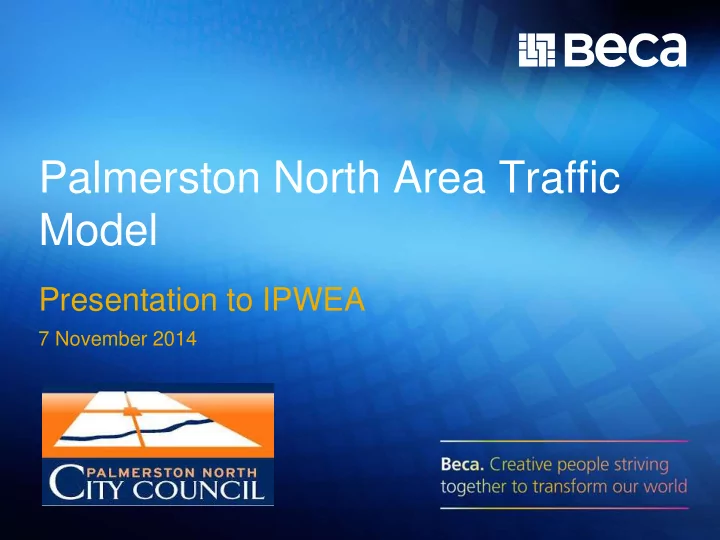

Palmerston North Area Traffic Model Presentation to IPWEA 7 November 2014
PNATM – Presentation Overview Model Scope and type Data collected The model Forecasting inputs Applications
PNCC Aims and Objectives Existing model was out of date and used obsolete software Greater temporal and spatial resolution required Uses the opportunity of the census data collection to fully reflect the changing demography of the district (incorporating 2012 boundary changes) Model to be used for: ─ Forward planning of the road network ─ District plan reviews ─ Specific projects eg Food HQ Model software to be flexible and widely used within NZ and overseas Desire for outputs that could be presented to Councillors etc
PNCC Procurement Process Budget of $400k approved by Council Independent Traffic Consultant engaged to assist in drafting the RFP and to assist in evaluating proposals Work not subsidised by NZTA, however procurement process aligned closely with NZTA Procurement Manual Procurement method was a Purchaser Nominated Price Independent Traffic Consultant retained by Council as Peer Reviewer throughout duration of contract
Scope – Physical Extent
Scope – Time Periods Old model only represented weekday PM Peak New model represents the following weekday time periods: ─ AM Peak: 2-hour weekday demand period of 7:30-9:30am with a peak-hour of 8:00-9:00am ─ PM Peak: 2-hour weekday demand period of 4:00-6:00pm with a peak-hour of 4:30-5:30pm ─ Interpeak: 6½ demand period of 9:30am-4:00pm with a peak-hour of 12:00-1:00pm Base year = 2013 Future years = 2021, 2031 and 2041
Scope - Model Type Traditional ‘3 - Step’ Traffic Model: ─ Trip generation (24-hr) ─ Trip Distribution (24-hr) ─ Trip Assignment (peaks) Fully ‘synthetic’ 16-category Household Structure Model 7 trip purposes Static ‘macro’ assignment Average weekday AM, PM, Interpeak and Daily Implemented in CUBE(VOYAGER)
Data Collection Census 2013 data ─ Land use data – population, households and employment ─ Census JTW for calibrating trip distribution model Demographic information – school/college role Count data – calibration/validation ─ PNCC counts ─ MDC/NZ Transport agency counts ─ Bespoke counts at specific locations PNCC travel time data – travel time validation SCATS Signal time data – network coding Horizons bus routes and patronage
Count sites
Bluetooth Data Capture
Bluetooth Data – Facts and Figures Data collected in April 2014 ─ Five day survey ─ 8 data collection locations ─ 15,000 individual journeys ─ 98 route permutations 17% sample size Cost effective alternative to ANPR First model in NZ to use Bluetooth as a data collection methodology Used for identifying external to external movements, key journey times and external to internal zone movements
Fleet GPS data capture Commercial GPS data used for: ─ HCV matrix and ─ Check of external-external movements ─ Selected travel times for validation Uses a range of different sources of commercial vehicle data, but largely derived from eRUC Data sampled over one month (March 2013) Sample size = c40% of HCVs, much lower proportion of LCVs and cars First traffic model in NZ to use fleet GPS data
The Model
Output – Traffic Flow
Output – Speed Drop (Link)
Output – Intersection Flow & Delay Intersection Flow Intersection Delay
Model Calibration and Validation Calibration = fit model to data Validation = check output against independent data Key Calibration/Validation checks ─ Screenline vehicle flow totals (by period and direction) ─ Individual link vehicle flow totals by period and direction ─ HCV flows at key locations. ─ Turning flows at key junctions ─ Travel times on key routes ─ Origin/destination patterns Model validates well against industry criteria
Forecasting Land use changes ─ Development areas ─ Regional economic growth (population and employment) ─ Changes to educational roles Trip making changes ─ Modal shift ─ Changes to trip rates ─ Travel Demand Management Network changes ─ New links ─ Intersection modifications
Growth Projections Average annual population growth rates for Palmerston North City (based on residential growth strategy) ─ Low growth = 0.2% per annum to 2031 ─ Medium growth = 0.7% per annum to 2031 ─ High growth = 1.2% per annum to 2031 Modeling assumes medium growth scenario Reductions in population in surrounding rural areas 1.1% growth in number of households to 2031 (corresponding drop in average household size) Growth is focussed on a couple of key areas (plus a small amount of infill spread across the city)
Growth Areas North East Fielding Industrial Zone City West Whakarongo Longburn
Model Applications and Next Steps Forecasting (2021, 2031 and 2041) Network and land use changes Applications ─ Area wide population and employment changes ─ Network changes (for example, second Manawatu river crossing) ─ Policy changes ─ Localised land use changes (new subdivisions, supermarkets etc) Lessons learnt regarding use of novel technology to be shared with the wider industry (NZMUGS)
Recommend
More recommend